Anesthesia For Blepharoplasty Surgery
Anesthesia for eyelid surgery
Most commonly, we perform eyelid surgery with sedation and local anesthesia. IV drugs are given to make you comfortable (Fentanyl and Versed are common), then a short acting drug (Propofol, remifentanyl, ketamine or a combination are common) is used to make you unaware for a few minutes while we inject numbing medicine under the skin (usually lidocaine and bupivicaine)
This is well tolerated and less risky than general anesthesia. Some doctors do choose to use general anesthesia depending on the patient’s level of anxiety and other simultaneous procedures.
Type of anesthesia for blepharoplasty
We can usually keep the patients very comfortable under any type of anesthesia. However, intravenous sedation or light general anesthesia is the best way to perform this operation under.
I am interested in upper and lower blepharoplasty with eye bag removal. Anesthesia?
This procedure can be done under a local, and or IV sedation. The IV sedation is a better choice only because the surgeon is working around the eyes, and this can be very uncomfortable for some patients
It can be very hard to get control of the pain with the local on the lower eyelids. If doing under local only, I recommend a little pain medication and relaxing medication by mouth. Upper blepharoplasty can be done under local anesthesia in most case
Upper/lower Blepharoplasty: what’s the best anaesthetic?
I personally find that blepharoplasty can easily be done under both General Anaesthetic or Local + Sedation. General is probably more common but either is completely reasonable.
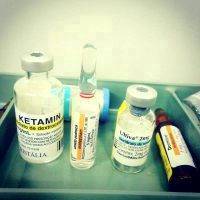
Blepharoplasty Is Performed With A Local Anaesthetic
Anesthesia for eyelid surgery
You can do eyelid surgery with either local or local sedation anesthesia. Upper eyelids can easily be done with just local, unless you are very anxious. I prefer to use some IV sedation for the lower lids
When we manipulate fat, and especially when we reposition it, it is uncomfortable with just local.
Anesthesia
Across the board, most commonly MAC anesthesia with local is used. This involves IV sedation with local anesthesia for the eyelids. General anesthesia is not required and only adds to postop nausea. It can also be done strictly with local anesthesia alone but most patients desire some addtional sedation
Blepharoplasty anesthesia
Blepharoplasty can be done under general anesthesia, Twilight sleep or local anesthesia. It all depends on the surgeon’s choice and the patient’s level of comfort and anxiety. There is no 1 correct choice that would suit all patient’s

For Upper Blepharoplasty Local Anesthesia Can Be Used, With Or Without General Sedation
If you would like to watch blepharoplasty under local anesthesia with mild sedation than please watch the link below.
Depend on what they planning to do for your lower eyelids
Usually the upper eyelid blepharoplasty, even if we are going to remove fat, is done under local injection. But some patient and surgeons prefer to have the patient sedated slightly. The same goes for lower eyelid, but the lower eyelid procedures are sometimes more involve and the patient needs to be slightly in deeper sedation
under very unusual sercomstaces the surgeon and the patient may prefer general anesthesia.
Anesthesia for blepharoplasty
Here are some general guidelines: upper eyelids can be done under local anesthesia in most cases; lower blepharoplasty usually requires some level of sedation to properly manipulate the fat pockets. Only an in person evaluation could determine the best approach for each individual case
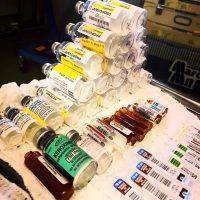
For Upper Eyelid Surgery Procedure Local Anesthesia Is Optimal
Blepharoplasty can be performed under IV sedation or with local injection alone. I prefer oral sedation and local anesthesia. My patients are comfortable, are not hung over after the procedure and have none of the more serious risks with IV sedation
Local anesthesia for eyelids
Don’t worry, the injections are not bad at all, a few pinches are felt, the skin to be excised is usually marked before the local is placed and the volume of local varies , say about 1-3cc per eyelid.
Expect about 7-10 days of recovery after which you will look pretty good and the remainder of the healing will occur over a few months. It’s a wonderful procedure to ‘brighten’ the eyes.(Dilip D. Madnani, MD, FACS, New York Facial Plastic Surgeon)

General Anesthesia For Eyelid Surgery
Blepharoplasty under local anesthesia
Some doctors do both upper and lower eyelid blepharoplasties under local anesthesia. While I will do upper blepharoplasty under local anesthesia, I prefer doing lower eyelids under general anesthesia because they can be more complicated to do.
Still, while it sounds barbaric, injections to numb the eyelids are not painful. Very small needles are used and the tissue separates very easily in most cases. You are correct that the injections may distort the tissue and make it harder for the surgeon to assess the results intra-operatively.
This is a case where the surgeon must really trust his/her pre-operative markings and not deviate from them too much (if any) during the procedure. (Edwin C. Pound, III, MD, Atlanta Plastic Surgeon)
Lower blepharoplasty under local anesthesia
Local Anasthesia Is Low Anesthetic Risk, Easy To Perform, Perfect Analgesia For 2 To 4 Hours, Better Bleeding Control And Finally A Lower Cost
The type of anesthesia used for a lower blepharoplasty procedure will vary, depending on the surgeon’s preference as well as the type of procedure being done. Keep in mind that some lower eyelid surgeries are more extensive than others.
Some patients require tightening of the lower eyelid supportive structures, which is more complicated than simple fat or skin removal. This is something you need to discuss with your surgeon. (Erik Miles, MD, FACS, Charlotte Plastic Surgeon)
I have performed lower eyelid surgery under a variety of anesthesia situations. This ranges from local anesthesia alone to general anesthesia. What exact procedure I perform and what anesthetic method is chosen depends on the patient, the patient’s health and what our goals are.
Safety and comfort are major considerations. Whether you would be a candidate could be determined at the time of an in-person consultation. Fred G. Fedok, MD FACS. (Fred G. Fedok, MD, FACS, Mobile Facial Plastic Surgeon)
Can lower eyelid surgery be done with local anesthesia?
The determination of what type of anesthesia to use for a particular procedure is based on the preferences of the surgeon and the patient. I perform lower eyelid surgery for bags with local anesthesia and IV sedation and then the patient can go home the same day after the procedure. (Michael I. Echavez, MD, San Francisco Facial Plastic Surgeon)
Local Anesthesia for a Facelift
Twilight is totally fine. You won’t remember anything, really, if it’s true twilight sedation. I commonly perform full facelifts under straight local anesthesia along with eyelid surgery and the patient do great. You finish the case wide awake feeling fine under local
With twilight you’ll be a little groggy. There’s a theoretical reduced risk with twilight or local versus general anesthesia. You’ll do fine.
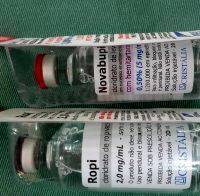
Local Anesthesia For Blepharoplasty
The person giving the anesthesia is more important than the type of anesthesia
The two sides, general vs. I. V. sedation, for facelift surgery will continue to argue with each other until long after I retire, which I don’t plan on doing for many years. There are advantages to both and disadvantages to both
The most important consideration is not the type of anesthesia being given but who is delivering it. The anesthesia should be given by an experienced board certified anesthesiologist or certified nurse anesthetist (CRNA) who is being supervised by an anesthesiologist
There is actually very little difference between a ‘light’ general anesthetic and a ‘heavy’ I. V. sedation.
Anesthesia
For twenty years, I did facelift and eyelid surgery under sedation. The major problems with this is over or under medicating. Under medicating leads to awareness and pain. Over medicating leads to airway blockage with no ability to place an airway
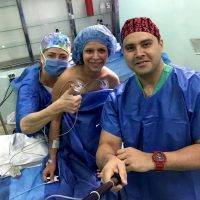
Monitored Anesthesia For Blepharoplasty
I now do most cases under light general anesthesia with airway protection.
Local Anesthesia with Sedation Best Experience for Facelift
Local anesthesia with some intravenous sedation usually works best. There is little discomfort after the local anesthesia is placed but the procedure is of several hours duration. It is difficult to lie still comfortably during this period of time
With intravenous sedation the procedure is comfortable and stress free. Usually, patients have little recollection of the procedure. But recovery after sedation is typically quick with little anesthesia “hangover”.
Anesthesia for face lift
At our facility, we offer IV sedation as well as local anesthesia with oral sedation. I believe for a 4-6 hour procedure with so many components, oral sedation and local anesthesia is not adequate and will likely lead to discomfort and movement during the procedure

Oral Sedation Or Twilight Sedation Have The Advantage Of Allowing The Patient To Return Home Faster After The Eyelid Surgery
I would recommend twilight iv sedation at an accredited facility by a board certified plastic or facial plastic surgeon.
Twlight anesthesia perfect for face and eyelid surgery
We find twilight anesthesia, or conscious sedation, perfect for facelift and eyelid surgery and you should do very well with it. Make sure that the facility used by your surgeon is accredited, and that the professional providing the sedation is well qualified
Anesthesia preferences for facelifts and eyelid surgery
Monitored twilight anesthesia with good local anesthesia technique is my preference for most patients. I can work better under the chin and around the neck. However general endotracheal anesthesia may be preferable for certain individuals
Facelift anesthesia
Although a facelift can be done under twilight anesthesia, most surgeons will use general anesthesia to better control your airway and minimize unexpected movements by the patient. The addition of other procedures lengthening the time of surgery can also produce more discomfort for the patient lying on an operatating table

Twilight Sedation For Eye Surgery
Talk to your surgeon and seek his/her advice and experience with anesthetic choices. General anesthesia done correctly has a high safety level.
Upper eye lid surgery is easily done under local. Depending on what her exam shows the lower lid could be done under local but in my practice I mainly do transconjunctival “SOOF lifts” and that cannot be done under local.
I believe this is a safer better procedure than a skin muscle flap lower lid bleph but the latter can be performed under local..
(M. Sean Freeman, MD, Charlotte Facial Plastic Surgeon)
Blepharoplasty under local anesthesia.
I have done many upper and lower lid blepharoplasties under local anesthesia and oral sedation. I believe it is safer for the patient with an easier recovery. I am sure you can find a surgeon in your area that can do it this way if requested.

What Type Of Anaesthesia Is Used During Blepharoplasty
You can research facial plastic surgeons and oculoplastic surgeons i your area. (Raymond E. Lee, MD, Orange County Facial Plastic Surgeon)
There are many anesthesia options for blepharoplasty. The type of anesthesia used depends on the patient, surgeon, and how involved the surgery is. Upper blepharoplasty is commonly performed under local anesthesia or under monitored anesthesia care (MAC).
MAC is sometimes referred to as “twilight” anesthesia. General anesthesia is rarely needed for upper blepharoplasty. Lower blepharoplasty can be a more complicated procedure, and is usually performed under MAC or even general anesthesia. Occasionally lower blepharoplasty can be performed under local anesthesia.
I would discuss you concerns with your surgeon and go over you options with them. (Ira Vidor, MD, Newport Beach Oculoplastic Surgeon)
Lower lid bleph
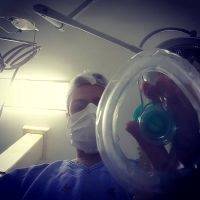
What Type Of Anesthesia Is Right For My Blepharoplasty
An anterior approach to the lower lid bleph can work well with local anesthesia and Valium. This involves a subciliary incision just under the lashes along the lower lid. (John Michael Thomassen, MD, Fort Lauderdale Plastic Surgeon)
Anesthesia for lower lid surgery
A lower lid bleph can be done with local only for some patients. This is true mostly if the surgeon is doing the surgery through an external or skin incision. When doing a transconjuctival approach, most patients will prefer some sedation as there can be a lot of pressure felt which the local will not eliminate.
Also, as we pull on the fat to either excise or reposition it can be uncomfortable. I do mostly fat repositioning, and have everyone use sedation. It makes it more comfortable for the patient and therefore more straight forward for me.
When patients start moving due to pain it can make the surgery difficult and can alter the results. If you use just some propofol, you should do pretty well with nausea – avoid the narcotics.
I have not used general anesthesia for any surgery in 25 years. (John J. Martin, Jr., MD, Coral Gables Oculoplastic Surgeon)
Local anesthesia for lower blepharoplasty
I can appreciate your concern. Lower blepharoplasty can be done under local anesthesia depending on the level of correction that is needed. If detachment of the arcus marginalis is done, I would suggest to undergo general anesthesia.
Transconjuntival fat removal and skin removal could be done under local anesthesia, however your surgeon should be proficient with the technique. Finally, make sure that you have a consultation with a board certified plastic surgeon.
Wishing you the best in your journe.(Julio Clavijo-Alvarez, MD, MPH, FACS, Pittsburgh Plastic Surgeon)
Anesthesia and issues
You are best to review your issues with you surgeon and anesthesiologist and they can work out a protocol to best serve you.(Steven Wallach, MD, New York Plastic Surgeon)
Upper eyelid surgery with Twilight Anesthesia is extremely comfortable
I perform most of my eyelid surgeries with IV sedation (aka twilight anesthesia). A patient yesterday stated she did not even feel the numbing at all. (Jason Lichtenberger, MD, Bellingham Facial Plastic Surgeon)
No pain
The way we do it, with sedation, there is no pain upon the insertion of the local anesthesia. Talk to you plastic surgeon and anesthesiologist and tell them of your concerns. (William B. Rosenblatt, MD, New York Plastic Surgeon)
Local Sedation Should Be Painless
Let the Anesthesiologist and your Surgeon no that you are concerned. The Anesthesiologist should be able to have you sleeping for the injection. In that situation, you will not feel the injection at all. Then your eyelid will be numb, and even if you are a little more awake, you won’t feel any discomfort for the rest of the surgery. (Marc Cohen, MD, Philadelphia Oculoplastic Surgeon)
Upper eyelid surgery easily done with sedation and local.
I don’t give much to worry about. I do many upper eyelids with sedation and local or local only. The same cannot be said of lower lids why prefer to put patients to sleep. (Vincent N. Zubowicz, MD, Atlanta Plastic Surgeon)
How painful is local anaesthesia?
No doubt local anaesthesia is a painful, however when combined with twilight sedation it will be painless and better still you should not have any recollection of the injection or the characteristic stinging pain that the local anaesethetic causes.
It is normal to be anxious prior to the procedure. (Stephen Salerno, MBBS, FRACS, Melbourne Plastic Surgeon)
Local anesthesia for eyelid surgery

Local Anestetic
Performing neck liposuction and lower eyelid blepharoplasty under local
It is possible to perform liposuction of the neck and a lower eyelid blepharoplasty at the same time. (Jeffrey Zwiren, MD, Atlanta Plastic Surgeon)
Local anesthesia for cosmetic surgery…. for sure!
This can be done under local anesthesia, even without any IV sedation. I perform all my cosmetic procedures this way, I do give some oral mediation that relaxes the patient and once the local anesthesia is in place, the procedures are very comfortable. (Dilip D. Madnani, MD, FACS, New York Facial Plastic Surgeon)
Local anesthesia
Upper eyelid surgery is finite enough that local anesthesia (even without any sedation ,whether by oral means ( pills ) or IV) is easily doable. We generally provide some medications by mouth to make the procedure more pleasant. I now encourage patient to do the procedure under local as it is simpler and well tolerated..
(John S. Alspaugh, MD, FACS, Virginia Beach Plastic Surgeon)
Board certified anesthesiologist for sedation or anesthesia
In many states around the country, there are state regulations about who can perform anesthesia. In our practice, Board certified physician anesthesiologists perform the anesthesia, while the surgeon performs the eyelid surgery. This is important for patient safety and comfort. (William Portuese, MD, Seattle Facial Plastic Surgeon)
Plastic surgeon to administer light sedation vs anesthesiologist? = consider pure local anesthesia #eyelidlift #drmesa
Cosmetic surgical procedures like eyelid lifts can be done under light sedation, regeral anesthesia or IV sedation. Sedation can be done with oral medications only (oral sedation) or medication through the vein ( “twilight sedation”). The stronger the degree sedation,the higher the risk of loosing the airway patently ( ability to breath expontaneously) which could be light treating in certain cases.
If cosmetic surgery is gong to be performed under significant sedation, this should be administered and monitored by a board certified anesthesiologist in an accredited facility. Patients worried about undergoing minor cosmetic surgical procedures like upper eyelid lift, should consider performing the procedure under pure local anesthesia without sedation.
In my practice, most of the eyelid lift patients as well as facelift fattened undergo eyelid lift and facelifts under local anesthesia without minimal discomfort or pain ( and of course not oral sedation) (John Mesa, MD, New York Plastic Surgeon)
The details are important here.
General light sedation means IV sedation. Most accrediting organizations require an anesthesia provider for this level of medication and specifically prohibit the surgeon and the nurse directly assisting the surgeon from providing this sedation. The concern is that the intravenous drugs are quite potent and a certain percentage of patients will require airway support even when administered drugs that provides “light” sedation for most other patients.
This is an anticipated effect and easily managed by the anesthesia provider ( anesthesiologist or nurse anesthetist). If the surgeon is actually giving you oral sedation with say a valium, this may be okay with the accrediting agency.
I recommend calling the AAAASF and speaking with them regarding what they require for this surgeon. If you are getting actual intravenous sedation, you are correct, you need an anesthesia provider other than your surgeon. (Kenneth D. Steinsapir, MD, Beverly Hills Oculoplastic Surgeon)
Anaestesia for Cosmetic Surgery
If the surgery is a procedure that can be done under local anaesthesia & relatively short in duration an oral assisted sedation is acceptable otherwise have an anesthesiologist present for safety . In response to an answer’s additional comments about who should perform certain Cosmetic procedures I would reply that Oculoplastic Surgeons , Facial Plastic Surgeons r as well trained if not more than General Plastic Surgeons to perform Facial Plastic surgery , so do your homework & find a competent MD to do your surgery ! (Jerrold Gendler, MD, FRCS, New York Facial Plastic Surgeon)
Local Anesthesia for Upper Bleph
Thank you for your great question. Simply put, it is totally reasonable, and preferable, to have an upper bleph performed under local anesthesia with light sedation. It is the safest way to go, and you will save some money not having to pay an anesthesiologist.
Typically our surgeon will give you a light sedative (ie valium or ativan) an hour before the procedure. Having personally operated this way for a decade, I can stand by this approach, especially if your surgeon does this method on a regular basis.
I’ve attached a video specifically discussing local anesthesia for facial procedures. (Paul Lanfranchi, DO, FAOCO, Las Vegas Facial Plastic Surgeon)